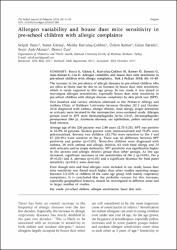| dc.contributor.author | Yazıcı, Selçuk | |
| dc.contributor.author | Güneş, Soner | |
| dc.contributor.author | Çokboz, Melike Kurtuluş | |
| dc.contributor.author | Kemer, Özlem | |
| dc.contributor.author | Baranlı, Gülce | |
| dc.contributor.author | Akman, Sezin Aşık | |
| dc.contributor.author | Can, Demet | |
| dc.date.accessioned | 2019-09-04T12:22:43Z | |
| dc.date.available | 2019-09-04T12:22:43Z | |
| dc.date.issued | 2018 | en_US |
| dc.identifier.issn | 00414301 | |
| dc.identifier.uri | https://doi.org/10.24953/turkjped.2018.01.006 | |
| dc.identifier.uri | https://hdl.handle.net/20.500.12462/6235 | |
| dc.description.abstract | The increase in the prevalence of allergic diseases in pre-school children who
are often at home may be due to an increase in house dust mite sensitivity,
which is rarely expected in this age group. In our study, it was aimed to
investigate allergen sensitivities, especially house dust mite sensitivity in
pre-school children with allergic disease complaints by skin prick test (SPT).
Two hundred and twenty children admitted to the Pediatric Allergy and
Asthma Clinic of Balıkesir University between October 2015 and October
2016 diagnosed with asthma, allergic rhinitis, food allergy, atopic dermatitis
or urticaria were involved in the retrospective cross-sectional study. Allergen
groups used in SPT were Dermatophagoides farina (Derf), Dermatophagoides
pteronyssinus (Der p), Alternaria alternata, cat epithelium, pollen mixture and
food mixture.
Average age of the 220 patients was 2.98 years (2.75-3.21). SPT was positive
in 55.9% of patients. Sixteen percent were monosensitized and 73.8% were
polysensitized. Seventy two children (32.7%) were sensitive to Der f and
67 (30.4%) were sensitive to Der p. There was no difference between SPT
positivity and gender (p>0.05). Ninty-five children were diagnosed with
asthma, 38 with asthma and allergic rhinitis, 63 with food allergy and 24
with urticaria and/or atopic dermatitis. SPT positivity was significantly higher
in the asthma and allergic rhinitis group than other groups. As the age
increased, significant increases in the sensitivities of Der f (p<0.01), Der p
(P<0.01) and A. alternata (p<0.05) and a significant decrease for food panel
sensitivity (p<0.01) were detected.
Even though skin and food allergies were included in our study, house dust
mite sensitivity was found much higher than other studies reporting ranges
between 3.5-23% in children of the same age group with mainly respiratory
complaints. It is concluded that the probable reasons for this increase,
especially geographical features, should be investigated in different areas and
in larger number of studies. | en_US |
| dc.language.iso | eng | en_US |
| dc.publisher | Turkish Journal of Pediatrics | en_US |
| dc.relation.isversionof | 10.24953/turkjped.2018.01.006 | en_US |
| dc.rights | info:eu-repo/semantics/openAccess | en_US |
| dc.subject | Pre-School Children | en_US |
| dc.subject | Allergen Sensitization | en_US |
| dc.subject | House Dust Mite | en_US |
| dc.title | Allergen variability and house dust mite sensitivity in pre-school children with allergic complaints | en_US |
| dc.type | article | en_US |
| dc.relation.journal | Turkish Journal of Pediatrics | en_US |
| dc.contributor.department | Tıp Fakültesi | en_US |
| dc.contributor.authorID | 0000-0002-6526-9460 | en_US |
| dc.identifier.volume | 60 | en_US |
| dc.identifier.issue | 1 | en_US |
| dc.identifier.startpage | 41 | en_US |
| dc.identifier.endpage | 49 | en_US |
| dc.relation.publicationcategory | Makale - Uluslararası Hakemli Dergi - Kurum Öğretim Elemanı | en_US |


















